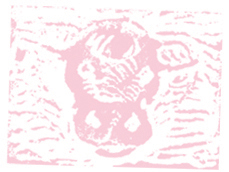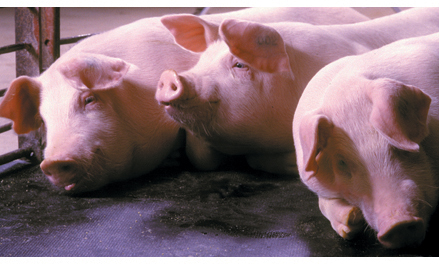


by Judy Bolyard Purdy
Intro
| Tangible
results | Cows,
cows & more cows
|
Genetic preservation | Pig
Tales
| The war against disease

Pig Tales
When Stice arrived at UGA in 1998, no one had yet succeeded in cloning a pig. Using the basics from his cattle cloning technique, Stice set out to do so. The project was especially challenging: Pig eggs and embryos are far more sensitive to handling than are those of cattle. Each step in the cloning process jars the fragile egg cells and reduces their viability. For reasons the team couldn’t quite pinpoint, very few of the fused eggs were surviving and growing into embryos that could be implanted into surrogate sows.
Time and again the UGA-ProLinia cloning team collected hog eggs, prepared them to be fused with genetic material from a prized hog, stimulated them to behave like fertilized eggs — and then watched and watched. More often than not, nothing happened. Weeks stretched into months with the team carefully, tediously, relentlessly extracting cell nucleus after cell nucleus, one at a time, from hundreds and hundreds of sow eggs and then ever so gently substituting nuclei from skin cells from the boar to be cloned.
Once or twice a week, someone in the lab — usually a graduate student — had to make the four-hour round-trip trek to the slaughterhouse and replenish the supply of sow eggs salvaged from the ovaries of hogs destined for ham, sausage and bacon. But no amount of babying the delicate cloned embryos produced the results they had gotten with cows.
“In cloning, everything has to come together and everything has to be right,” Stice said. “We’re doing something different than everybody else in our effort to clone adult animals in a more efficient way. We’re trying to use resources and techniques that other people haven’t.”
This past May, their arduous efforts finally paid off when three healthy, pink pigs were born.


At three months old, Yoda, Willie and A Boy Named Sue (L to R) — the first three pigs cloned at UGA — weigh in at 110 pounds each.
Although it’s more difficult to get pig embryos to grow and thrive in the first seven days before they are placed in a surrogate sow, once the sows become pregnant, matters seem to get easier. Stice said he believes that the hog industry actually will move cloning into mainstream commercial operations quicker than cattle producers will.
“In five years I think you’ll see the number of cattle being produced from clones will be in the hundreds of thousands,” he said. “And it will probably be even sooner for cloned pigs because the industry is set up to adopt the technology more easily.”
Better cloning efficiency will mean lower pork production costs and quicker response to consumer demands, he said.
“For example, the Japanese like darker pork meat with more fat. We’ve bred our animals away from these qualities,” Stice said. “Cloning makes it much faster to respond.”
A report issued by the National Academy of Sciences in August, which concludes that cloned animals don’t seem to pose risks for human consumption, may speed cloned pork chops and Porterhouse steaks to the butcher’s meat case.
As a result of that report, Stice said he “expects the offspring of cloned meat will be approved for human consumption.”
Stice also sees his hog cloning research providing benefits beyond the dinner table. He plans to branch out toward medical applications, not to clone spare parts for people, but to develop animals that can serve “as models for research into diseases such as Alzheimer’s.”
“I’d like to use cloning techniques to develop an animal model for Alzheimer’s,” he said. “The mouse is not a good model. A mini swine could be a test model for human Alzheimer’s.”
Stice sees the mini swine as a way to speed the development of more effective drugs and treatments for Alzheimer’s and for another disease that strikes people at the opposite end of the age spectrum. Ataxia Telangiectasia, a progressive, genetic disease caused by a mutation in just one gene, begins with loss of balance among small children and results in their death, often by the late teen years.
“We’re looking at knocking out that gene in a mini pig so it could be used as a model for AT,” he said.
Intro
| Tangible
results | Cows,
cows & more cows
|
Genetic preservation | Pig
Tales
| The war against disease
For comments or for information please e-mail the editor: jbp@ovpr.uga.edu
To contact the webmaster please email: ovprweb@uga.edu
![]()